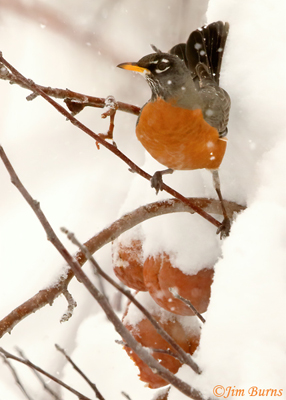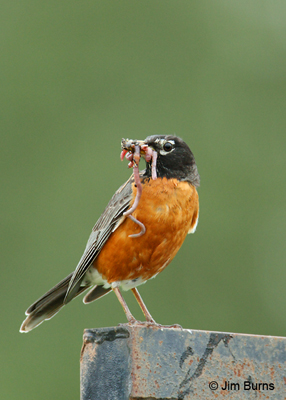
Recently, sorting through my photo files for a shot of an American Robin someone had requested, I found myself slowly slipping down a familiar rabbit hole. “Robin.” I think about a girl I knew in school, and then another Robin, an adult friend who laughingly told me if she were twenty years younger, her name would have been spelled Robyn. And sure there’s robin-red-breast, but robin-egg-blue is also a thing.
And then the memories begin to flow. On the first field trip I ever took as a beginner, I recall a birder visiting from England gasping over the “most beautiful bird” she’d ever seen, bright orange below, smashing black on white throat striping, ivory eye arcs! It took several minutes for even the jaded amongst the group to realize she was gushing over her first American Robin. It was a seminal moment that later informed me when I began leading field trips myself. One birder’s lifer may be commonplace to others.
Robin is a bird I grew up with in the Midwest, long before I was a birder. Robins were in our yard every day, and I will never forget the fun conundrum about the species’ feeding strategy—does the robin see the worms or does it hear them? I remember as a child hearing my mother, an observer of birds but not really a birder, telling me to watch the robins cock their heads sideways as they bounced across our lawn, four quick steps, pause and cock, then repeat. She said, as many originally thought, they were putting one ear to the ground to listen. Science has since proven the robin is, in fact, looking, and does, in fact, see the worm. Imagine hearing a worm doing its thing in the ground!
We lived next door to a “Cat Lady,” who kept twenty some cats, none of them indoor cats as far as we could tell, so we and the neighborhood robins lived in mortal fear for the birds’ safety. It was years later, on my first trip for spring migration at Ohio’s Magee Marsh, that I photographed my first American Robin nest only arm’s length off the famous boardwalk. A birding friend from Phoenix suddenly appeared beside me. He was embarrassed he hadn’t even told me he was coming. I was more embarrassed he had caught me photographing such a common bird when Eastern warblers, many of them lifers, were feeding in the foliage all around us.
The following year, in Minnesota on a hike to a marsh to successfully photograph Connecticut Warblers for the first time, I finally got my cliché photograph of an adult American Robin with a beak full of earthworms. Since then I have shots of American Robins hover plucking Pyracantha berries in California, drinking from a mountain spring in New Mexico, and blending in, camouflaged, with fallen autumn leaves in Wyoming. And I have fond memories of all those adventures and the people with whom I shared them.
Last month I saw an American Robin at my “local patch,” my first record of this species there in literally hundreds of visits over the years. I assumed this might lend credence to the idea that the Valley would get an “invasion” of mountain species this winter, but I’ve seen no indication of it yet besides my vagrant robin which was skulking around underneath desert bushes, certainly an unexpected sight.
In retrospect, my most memorable American Robin sighting is the one memorialized in my favorite photograph of the species, the one which opens this column. On a grim, gray winter’s day in the foothills of the Uinta Mountains outside of Provo, Utah, we came across a cold, deserted apple orchard, color still clinging to the few now surely frozen apples still clinging to snow laden branches. Just as snow began to fall again, a robin dropped from nowhere—why hadn’t it gone south already--onto a bunch of apples and began pecking away, its breast perfectly matching the color of the fruit, both simply glowing against the stark white, wintry background.
“Robin.” I have nearly a hundred photographs in my portfolio, but many hundreds of snapshots in my cerebral cortex where memories linger. One word unlocks them all, then links them together.